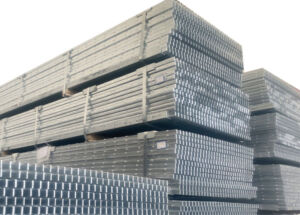Anti-slip serrated grating is a vital component in various industrial and architectural applications. Its design is specifically engineered to enhance safety. The serrated surface provides an increased coefficient of friction, which is crucial in areas where people or vehicles may encounter slippery conditions. For example, in industrial walkways, platforms near machinery, or loading docks, this grating significantly reduces the risk of slips and falls.
The manufacturing process of anti-slip serrated grating involves precise techniques. High-quality steel is typically used as the base material. The serrations are carefully formed, either through machining or specialized welding processes. This ensures that the serrations are uniform in depth and spacing, maximizing their anti-slip effectiveness. Additionally, the grating can be further treated, such as through galvanizing, to enhance its durability and resistance to corrosion.

One of the key advantages of anti-slip serrated grating is its versatility. It can be customized to fit different sizes and shapes of installations. Whether it’s a small access platform or a large industrial floor area, the grating can be fabricated accordingly. Moreover, it can be combined with other safety features, like side rails or drainage holes, to create a comprehensive safety solution. For instance, in a wet processing plant, the grating with drainage holes allows water to pass through while maintaining a safe walking surface.
In terms of maintenance, anti-slip serrated grating is relatively easy to manage. Regular inspections can quickly identify any damage or wear to the serrations. If needed, simple cleaning or minor repairs can restore its anti-slip properties. The durability of the grating also means that it requires less frequent replacement compared to some other flooring options. This not only saves costs but also minimizes downtime in industrial operations.
The future of anti-slip serrated grating looks promising. With the continuous advancement of technology, new materials and manufacturing techniques may further improve its performance. For example, the development of more durable coatings could enhance its corrosion resistance and extend its service life. Additionally, as safety regulations become more stringent, the demand for high-quality anti-slip serrated grating is likely to increase in various sectors, from construction to manufacturing and beyond.

